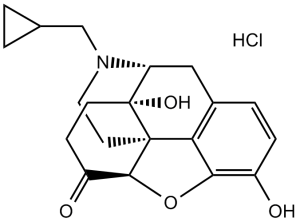
| 规格 | 价格 | 库存 | 数量 |
|---|---|---|---|
| 100mg |
|
||
| 250mg |
|
||
| 500mg |
|
||
| 1g |
|
||
| 2g |
|
||
| Other Sizes |
|
| 体外研究 (In Vitro) |
体外活性:纳曲酮 (0.32 mg/kg) 在恒河猴中维持最大反应(1% 或 2%)的浓度下可减少乙醇增强的反应。纳曲酮 (0.1 mg/kg) 会降低乙醇强化反应,无论是在产生少量乙醇摄入量 (g/kg) 的低乙醇浓度 (0.25%) 下,还是在产生大量乙醇摄入量的较高浓度 (4%) 下。 Naltrexone (1-3 mg/kg) 有效且剂量依赖性地抑制由充满 8% 乙醇的液体铲斗的非偶然输送产生的乙醇寻找的恢复。当纳曲酮以约 100 ng/kg 与吗啡 (3 mg/kg) 共同给药 (ip) 时,可最大程度地增强小鼠吗啡镇痛效力。在大鼠甩尾试验中,纳曲酮(10 ng/kg ip)可增强急性次最大剂量鞘内(5 mg)或全身(7.5 mg/kg ip)吗啡产生的镇痛作用。纳曲酮与吗啡合用可抑制吗啡镇痛作用的下降并防止大鼠吗啡效力的丧失。纳曲酮显着抑制乙醇自我给药并防止乙醇引起的透析液多巴胺水平增加。纳曲酮完全防止产前应激 (PS) 男性肛门生殖器距离的缩短,并恢复两性的生长速度。纳曲酮还可以降低 PS 大鼠在十字迷宫中的焦虑,增加探索的阿片类药物成分以控制水平,但会增加对照雄性大鼠的焦虑 激酶测定:细胞测定:
|
||
|---|---|---|---|
| 体内研究 (In Vivo) |
在成年雄性 Sprague-Dawley 大鼠中,超低剂量的纳曲酮(16.7、20.0 和 25.0 ng/kg)与吗啡(1mg/kg)联合使用延长了吗啡诱导的条件性位置偏爱的持续时间。在雄性 Wistar 大鼠中,纳曲酮显着抑制乙醇的自我给药,并防止乙醇激活的透析液多巴胺含量增加。纳曲酮亚慢性治疗导致乙醇自我给药逐渐减少。单剂量的纳曲酮会增加灭绝并减弱提示诱导的乙醇强化行为的恢复。在恒河猴中,纳曲酮降低了乙醇或蔗糖非选择性保持的行为。
|
||
| 动物实验 |
|
||
| 毒性/毒理 (Toxicokinetics/TK) |
Effects During Pregnancy and Lactation
◉ Summary of Use during Lactation Limited data indicate that naltrexone is minimally excreted into breastmilk. If the mother requires naltrexone, it is not a reason to discontinue breastfeeding. ◉ Effects in Breastfed Infants A 1.5-month-old breastfed infant of a mother who was taking 50 mg of oral naltrexone daily during pregnancy and lactation was reportedly healthy with no naltrexone-related adverse effects. ◉ Effects on Lactation and Breastmilk Relevant published information was not found as of the revision date. |
||
| 参考文献 |
:Psychopharmacology (Berl).1998 Sep;139(1-2):53-61;Eur J Pharmacol.1999 Jun 25;374(3):321-7.
|
||
| 其他信息 |
Naltrexone hydrochloride is a hydrochloride obtained by reaction of oxycodone with one molar equivalent of hydrochloric acid. it is a mu-opioid receptor antagonist that is used to treat alcohol dependence. It has a role as a mu-opioid receptor antagonist, an antidote to opioid poisoning and a central nervous system depressant. It contains a naltrexone(1+).
Naltrexone Hydrochloride is the hydrochloride salt of naltrexone, a noroxymorphone derivative with competitive opioid antagonistic activity. Naltrexone and its metabolite 6-beta-naltrexol reverse the effects of opioids by binding to various opioid receptors in the central nervous system CNS), including the mu-, kappa- and gamma-opioid receptors; opioid effects of analgesia, euphoria, sedation, respiratory depression, miosis, bradycardia, and physical dependence are inhibited. Naltrexone is longer-acting and more potent compared to naloxone. Derivative of noroxymorphone that is the N-cyclopropylmethyl congener of NALOXONE. It is a narcotic antagonist that is effective orally, longer lasting and more potent than naloxone, and has been proposed for the treatment of heroin addiction. The FDA has approved naltrexone for the treatment of alcohol dependence. See also: Naltrexone (has active moiety); Morphine Sulfate; Naltrexone Hydrochloride (component of); Bupropion Hydrochloride; Naltrexone Hydrochloride (component of) ... View More ... |
| 分子式 |
C20H23NO4.HCL
|
|
|---|---|---|
| 分子量 |
377.86
|
|
| 精确质量 |
377.139
|
|
| CAS号 |
16676-29-2
|
|
| 相关CAS号 |
16590-41-3 (free);16676-29-2 (HCl);
|
|
| PubChem CID |
5485201
|
|
| 外观&性状 |
Typically exists as solid at room temperature
|
|
| 密度 |
1.47 g/cm3
|
|
| 沸点 |
558.1ºC at 760 mmHg
|
|
| 熔点 |
274-2760C
|
|
| 闪点 |
291.4ºC
|
|
| 蒸汽压 |
2.71E-13mmHg at 25°C
|
|
| LogP |
2.265
|
|
| tPSA |
70
|
|
| 氢键供体(HBD)数目 |
3
|
|
| 氢键受体(HBA)数目 |
5
|
|
| 可旋转键数目(RBC) |
2
|
|
| 重原子数目 |
26
|
|
| 分子复杂度/Complexity |
621
|
|
| 定义原子立体中心数目 |
4
|
|
| SMILES |
Cl[H].O1C2=C(C([H])=C([H])C3C([H])([H])[C@]4([H])[C@@]5(C([H])([H])C([H])([H])C([C@@]1([H])[C@@]5(C=32)C([H])([H])C([H])([H])N4C([H])([H])C1([H])C([H])([H])C1([H])[H])=O)O[H])O[H]
|
|
| InChi Key |
RHBRMCOKKKZVRY-ITLPAZOVSA-N
|
|
| InChi Code |
InChI=1S/C20H23NO4.ClH/c22-13-4-3-12-9-15-20(24)6-5-14(23)18-19(20,16(12)17(13)25-18)7-8-21(15)10-11-1-2-11;/h3-4,11,15,18,22,24H,1-2,5-10H2;1H/t15-,18+,19+,20-;/m1./s1
|
|
| 化学名 |
(4R,4aS,7aR,12bS)-3-(cyclopropylmethyl)-4a,9-dihydroxy-2,4,5,6,7a,13-hexahydro-1H-4,12-methanobenzofuro[3,2-e]isoquinolin-7-one;hydrochloride
|
|
| 别名 |
|
|
| HS Tariff Code |
2934.99.9001
|
|
| 存储方式 |
Powder -20°C 3 years 4°C 2 years In solvent -80°C 6 months -20°C 1 month |
|
| 运输条件 |
Room temperature (This product is stable at ambient temperature for a few days during ordinary shipping and time spent in Customs)
|
| 溶解度 (体外实验) |
|
|---|
| 制备储备液 | 1 mg | 5 mg | 10 mg | |
| 1 mM | 2.6465 mL | 13.2324 mL | 26.4648 mL | |
| 5 mM | 0.5293 mL | 2.6465 mL | 5.2930 mL | |
| 10 mM | 0.2646 mL | 1.3232 mL | 2.6465 mL |
1、根据实验需要选择合适的溶剂配制储备液 (母液):对于大多数产品,InvivoChem推荐用DMSO配置母液 (比如:5、10、20mM或者10、20、50 mg/mL浓度),个别水溶性高的产品可直接溶于水。产品在DMSO 、水或其他溶剂中的具体溶解度详见上”溶解度 (体外)”部分;
2、如果您找不到您想要的溶解度信息,或者很难将产品溶解在溶液中,请联系我们;
3、建议使用下列计算器进行相关计算(摩尔浓度计算器、稀释计算器、分子量计算器、重组计算器等);
4、母液配好之后,将其分装到常规用量,并储存在-20°C或-80°C,尽量减少反复冻融循环。
计算结果:
工作液浓度: mg/mL;
DMSO母液配制方法: mg 药物溶于 μL DMSO溶液(母液浓度 mg/mL)。如该浓度超过该批次药物DMSO溶解度,请首先与我们联系。
体内配方配制方法:取 μL DMSO母液,加入 μL PEG300,混匀澄清后加入μL Tween 80,混匀澄清后加入 μL ddH2O,混匀澄清。
(1) 请确保溶液澄清之后,再加入下一种溶剂 (助溶剂) 。可利用涡旋、超声或水浴加热等方法助溶;
(2) 一定要按顺序加入溶剂 (助溶剂) 。
Naltrexone Treatment for Prolonged Grief Disorder (PGD)
CTID: NCT04547985
Phase: Phase 4 Status: Terminated
Date: 2024-08-28